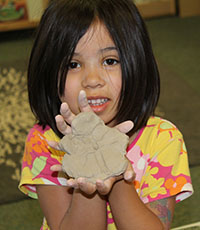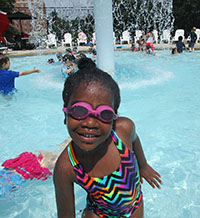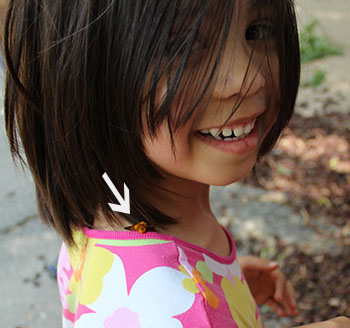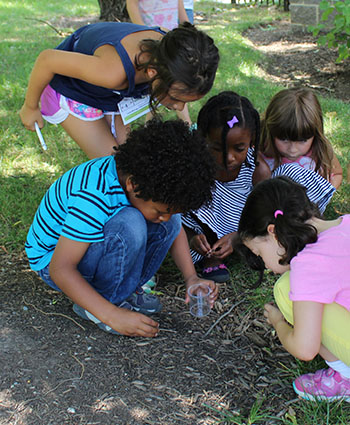
| Home | Week 1 | Week 2 | Week 3 | Week 4 | Week 5 | Week 6 | |
|---|---|---|---|---|---|---|---|
Teacher's Corner
Week 4 Lesson Plan
Pumpkins in July? The scarecrow made by the children last October had a pumpkin for a head. It was left in the garden as compost material all winter and early this spring the seeds sprouted! So far about six big pumpkins have grown. Two of them are white.

Here is a sampling of Maryland State standards met:
Science 1C1b-Describe and compare things in terms of number, shape, texture, size, weight, color, and motion.
The six pumpkins in the garden were compared by color and size. Children lifted them to see which weighed more. The pumpkins were cut open on the playground and children estimated how many seeds there might be inside. When the white pumpkin was cooked and mashed children compared it to the consistency of apple sauce.
Journal Writing-
CCSS.ELA-Literacy.W.K.3- Use a combination of drawing, dictating, and writing to narrate a single event or several loosely linked events, tell about the events in the order in which they occurred, and provide a reaction to what happened.
Journal writing has been encouraged though children find other ways to express their writing. This entry shows the children discovering insects on the playground and the child lets you know her reaction is pure love.

Science1D3a- Explain that a model of something is different from the real thing but can be used to learn something about the real thing.
After exploring real fossils and fossils in books, children made impressions in clay to replicate how fossils might start out. "This bug got trapped in mud", was one comment made while making clay models.

Physical Education 1A1d- Demonstrate a variety of locomotor skills using various speeds.
Twice a week we go to the pool just across the street from camp. Children are learning to get used to the water, put their faces in, and kick, and move their arms in a swimming fashion. Learning to swim is an important life skill for everyone.

Week 4

 Bug Hotel -Several images of bug hotels were shown to the children. Bug hotels are actually man made places that try to attract pollinators and other beneficial insects. These have become quite the rage and a quick search brought up many images. The children constructed their own list of materials they thought would be useful in making a good hotel, and then went on a scavenger hunt to collect the supplies. Campers got a kick out of using hand drills to bore holes in scrap wood. The holes were for insects to crawl in. One boy made a sign on the wood that said, "Bug Hotel, termites are not invited".
Several bugs were noticed to hover around the structures as it was completed.
Bug Hotel -Several images of bug hotels were shown to the children. Bug hotels are actually man made places that try to attract pollinators and other beneficial insects. These have become quite the rage and a quick search brought up many images. The children constructed their own list of materials they thought would be useful in making a good hotel, and then went on a scavenger hunt to collect the supplies. Campers got a kick out of using hand drills to bore holes in scrap wood. The holes were for insects to crawl in. One boy made a sign on the wood that said, "Bug Hotel, termites are not invited".
Several bugs were noticed to hover around the structures as it was completed.
 Beetles- There is a tree on the CYC playground that is covered in ladybug larva, pupa, and adult lady bugs. Between this and the ladybug classroom habitat, there is great excitement about this particular beetle. Two days worth of meetings were spent talking about beetles in general. Children learned that beetles are insects first, with the three body parts and six legs, but they also possess wing casings to protect their delicate wings. Campers were able to observe this on the playground from a newly hatched ladybug whose wings were laid out to dry. The photo on the left shows a girl giving the ladybug a ride on her shoulder. The Beetle Book by Steve Jenkins was a great resource to read with many pictures showing what beetles eat, how they battle, and their life cycle.
Beetles- There is a tree on the CYC playground that is covered in ladybug larva, pupa, and adult lady bugs. Between this and the ladybug classroom habitat, there is great excitement about this particular beetle. Two days worth of meetings were spent talking about beetles in general. Children learned that beetles are insects first, with the three body parts and six legs, but they also possess wing casings to protect their delicate wings. Campers were able to observe this on the playground from a newly hatched ladybug whose wings were laid out to dry. The photo on the left shows a girl giving the ladybug a ride on her shoulder. The Beetle Book by Steve Jenkins was a great resource to read with many pictures showing what beetles eat, how they battle, and their life cycle.

Fossils- Ms Wiest brought in her personal bug fossil collection to share. Some children were already very interested in prehistoric life and were able to contribute a lot of information to a discussion on fossils. One boy sang a bit of a song about paleontologists and another girl had heard about a very large dragonfly fossil. Children even started talking about the theorized demise of the dinosaurs. One of Ms. Wiests fossils is featured in the field guide book Fossils by David Ward. It is a beetle that had fallen into the La Brea tar pits in California. Other fossils shared included amber with insects trapped in it, and some trilobites that belong to the family of Arthropods.
Clay was put out along with shells and rubber bugs for children to make an imprint in to see how some fossils are created. One girl painted a picture using color combinations she had mixed herself to look like the colors she had seen in the amber.
 Patuxent Wildlife Visitors Center- Because the center was busy, Dennis Hartnett, a naturalist from the center, brought the program to us. Mr. Dennis greeted the children by asking them what they already knew about insects or to name an insect. Each child was able to chime in with some type of insect or a fact about them, for instance, "They have exoskeletons". Mr. Dennis went over the life cycle of a dragonfly which was a little different than that of a beetle and the children learned the word nymph. Then he gave each child a chunk of Model Magic and some pipe cleaners and instructed them to create an insect. When everyone had completed this task and had sculpted a bug that had six legs and two antennae, he gave the children a bag of parts to construct a dragonfly. Children carefully listened to each step before completing their own dragonfly to take home. In the end he gave campers an activity book to take home with facts about insects and coloring pages. The children gave him a "two antennae up" for the presentation.
Patuxent Wildlife Visitors Center- Because the center was busy, Dennis Hartnett, a naturalist from the center, brought the program to us. Mr. Dennis greeted the children by asking them what they already knew about insects or to name an insect. Each child was able to chime in with some type of insect or a fact about them, for instance, "They have exoskeletons". Mr. Dennis went over the life cycle of a dragonfly which was a little different than that of a beetle and the children learned the word nymph. Then he gave each child a chunk of Model Magic and some pipe cleaners and instructed them to create an insect. When everyone had completed this task and had sculpted a bug that had six legs and two antennae, he gave the children a bag of parts to construct a dragonfly. Children carefully listened to each step before completing their own dragonfly to take home. In the end he gave campers an activity book to take home with facts about insects and coloring pages. The children gave him a "two antennae up" for the presentation.

Mount Rainier Nature Center- Two naturalists from the Mount Rainier Nature Center came to the Yellow Room and gave a talk about bugs. Using posters, displays and live insects the children learned about habitats and life cycles of insects. The children were able to pet two Madagascar Hissing cockroaches and learned that you can tell the temperature by counting cricket chirps. Campers were excited to show the naturalists some of the insects in the Yellow Room. Perhaps the best part was going outside for a scavenger hunt with bug nets and containers. Children formed groups of three and worked as a team to find an example of the insects pictured on a bingo card. Spiders, ants, bees, butterflies, and a live cicada were found among other bugs. The timing for this activity was exciting for some children since it took place during their regular rest time. Giant thank you notes were written on chart paper with help from the campers, for both the Mount Rainier Nature Center naturalists and the Patuxent Wildlife Visitors Center.

Muffins- The CYC garden produced six or so sizable pumpkins all. Several were picked and the seeds scooped out right on the playground. Later the seeds were cooked and enjoyed by everyone. One pumpkin became a jack-o-lantern but a white pumpkin was cooked and mashed into a pumpkin muffin recipe. Children took turns stirring the ingredients to the count of 10. They counted to ten in several different languages too, including Korean, Spanish, and French. They also took this opportunity to count to 100 by 10's! We made ours without cinnamon or nutmeg due to allergies in the room. It could also be made with egg substitute and soy milk for children with those allergies. This was a very popular treat and many children asked for the recipe so we are sharing it here.
Pumpkin Muffin Recipe Read more about our pumpkins in the side bar.